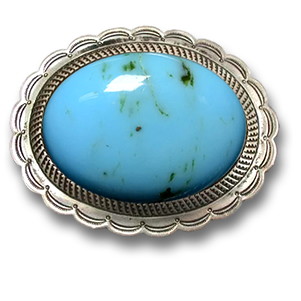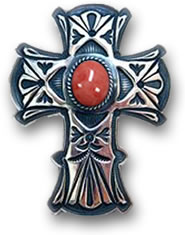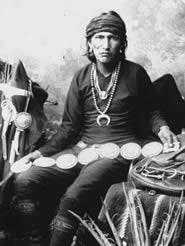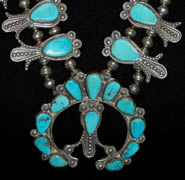|
Reviewed By Andreas Zabczyk
Native American Navajo Tribal Jewelry
Turquoise and Silver Buckle
The Navajo tribe of Southwestern America has long been famous for their jewelry and crafting techniques. In fact, the Navajo tribe is credited with teaching jewelry-making techniques to the many other indigenous groups of Southwestern America. Although ethnic tribal jewelry has been discovered in the Southwest dating back to 8800 BCE, the skillful art of making Native American Navajo jewelry truly began to take shape around the time of Spanish influence during the 16th century. In addition to learning techniques from Spanish visitors, Mexican leather workers contributed to Native American jewelry craft by teaching them the art of silver 'stamping', which has become a signature aspect of most authentic Native American jewelry pieces today. 
Stamped Silver and Coral Cross
When Spanish travelers first came into regular contact with Native Americans hundreds of years ago, they shared their silversmithing knowledge with the Navajo Native American Indian Tribe. Up until the late 19th century, most Navajo jewelry was composed of only worked leather or silver, generally with very plain designs that were marked or stamped with surface decorations. Although turquoise gemstones have been prized for thousands of years, it wasn't until 1880 that the first-known turquoise gemstone was actually set into a piece of silver Navajo jewelry. The first Navajo tribesman to work silver into jewelry was Atsidi Sani. Later, Atsidi Chon, another Navajo tribesman would be the first to ever set turquoise into silver jewelry. Both helped teach the craft to others in their own tribe as well as neighboring tribes such as the Pueblo people. Atsidi Sani had a younger brother named 'Slender Maker of Silver', who is credited with innovations that helped shape the history of Navajo jewelry. 
Atsidi Sani Navajo Silversmith
Turquoise has been the traditional favorite for most Native American jewelry craftsmen. After the Navajo introduced turquoise gemstones into their designs, they began to incorporate coral and various other types of semi-precious gemstones around the turn of the 20th century. Originally, Navajo jewelry was made only for other fellow tribesmen and neighboring tribes, but as more and more traders passed through the American Southwest by railway, the demand for fine Navajo jewelry caused an international commercial uprise. With the increase of commercial demand and trade, turquoise became increasingly abundant as new mines began opening up in Southwest America. This, combined with access to better quality tools, gave the Navajo craftsmen the ability to continue supplying the ever-growing demand for silver jewelry to traders from all over the world. The Navajo had become so skilled in the art of metalworking that they even were known to supply other tribes with 'blank' settings for their own lapidaries to set stones into. 
Squash Blossom Necklace
Navajo silversmiths often melted down silver coins so that they could turn it into jewelry. They would also trade other silver ornaments that could be melted, such as candlesticks, flatware and teapots. Navajo craftsmen gained quite a reputation for creating excellent quality concha belts, crosses, buckles, spurs and canteens. However, one of the most highly sought-after Navajo designs was a crescent-shaped pendant design known as 'najas'. Najas pendants were cast from hammered silver, usually stamped or chiseled with decorative tribal patterns and set with colorful gemstones. The concept of the crescent pendant has been seen in artifacts stemming from various other cultures as well, including Roman, Greek and Spanish. Najas pendants were commonly used as centerpieces for 'squash blossom necklaces', a Spanish inspired necklace design. Squash blossom necklaces were very popular for trade since they were believed to protect people and horses from bad spirits. Navajo jewelry has come a very long way over the years. Navajo silverwork and jewelry is highly desired by gem and jewelry collectors for its incredible value and intricate detail. Traditional Navajo jewelry is handmade by some of the world's most talented artisans. Although many have attempted to commercially replicate and mass-produce Navajo imitation pieces, none have succeeded in matching the quality found only in authentic Native American Navajo jewelry. This Page in Other Languages
|
| STAY IN TOUCH | NEWSLETTER |
| *You're signing up to receive GemSelect promotional email. |
Copyright © 2005-2024 GemSelect.com all rights reserved.
Reproduction (text or graphics) without the express written consent of GemSelect.com (SETT Company Ltd.) is strictly prohibited.
2512